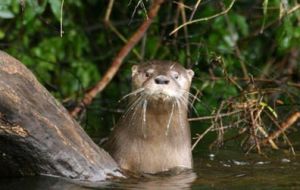MercoPress. South Atlantic News Agency
Otters in southern Chile help contain invasion of exotic mink
 The huillín or Chilean Patagonia otter (Photo by JL Barthled)
The huillín or Chilean Patagonia otter (Photo by JL Barthled) With its pert face and furry coat, the slender mink looks like a charming pet. But beneath the sweet façade lies an opportunistic predator that has become a menace to biodiversity in the southern parts of Chile.
Introduced in South America in the 1930s for the purpose of commercial fur production, the mink is one of the most ruthless invasive species that has ever attacked Chile. It has a voracious appetite for bird eggs, adult birds of many species and their young, rodents, fish, crustaceans, insects and amphibians, including many that are unique to Chile.
Widely distributed throughout Patagonia, the small predator has even invaded islands off the coast of the mainland.
Attempts to control the mink population in southern Chile have been unsuccessful thus far. But now there is a sign of hope for the coast of the Aysén Region (Region XI).
On Magdalena Island, the population of these intruders has dropped by 80% in less than a year. The discovery was made in a study by the program of Conservation Medicine at Universidad Andrés Bello, led by biologist Gonzalo Medina, who spent four years monitoring the pests in that region.
The agent responsible for the minks’ sudden demise would be the huillín, a river otter endemic to Chile which is prominently listed as an endangered species.
Both animals compete for habitat and food, but the native otter has one significant advantage: its size.
The huillín is aggressive and weighs more than 31 pounds, compared to the 7 pounds of the shy mink. Where there are huillíns, there are no minks. Although it has never been directly observed by scientists, locals have reported seeing the burly otter chasing the intruder, Medina said.
Scientists dismiss the notion that the otters could actually be eating the minks. “In our analysis of huillín feces, we have not seen anything like that,” Medina said.
In Europe, recent studies have also shown that the presence of otters corresponds with a reduced incidence of mink appearances.
If the mechanisms behind the minks’ disappearance are clear, without a doubt, the island could serve as a starting point for a national strategy for the eradication of the mink. A first step would be to reintroduce the huillín into other islands plagued by the mink and then, later, onto the mainland.
Biologist Agustín Iriarte sees this as the most complicated step.
“The huillín is currently only found along the coastline and in some large rivers,” he says. “But the mink has been spotted in the streets of Coyhaique.”
Medina acknowledged that the huillín would not be able to eradicate the mink, but to whatever extent its population can be augmented there would be a significant impact on the number of invaders in the area.
He said more study was needed, considering that scientists had so far only managed to collect indirect evidence of a decline in mink numbers, such as fewer tracks, droppings or burrows.
By the year’s end, Medina plans to go back to the area to install remote transmitters on both the otters and minks to follow them electronically. Scientists will then better understand how the presence of one animal may influence the behaviour of the other.
Arriving on the island is no easy feat. It is 50 minutes by motorboat from Port Swan to an impenetrable forest barely touched by humans, where scientists must camp for months.
Last winter, they were unable to reach the island because of snow and fierce winds.
Scientists plan to extend the project to the Vicente Pérez Rosales Park in the Lakes District and to other southern islands.
They say they are willing to do whatever it takes to curb the insatiable mink.
By Adrienne Lee – Santiago Times




Top Comments
Disclaimer & comment rules-

-

Read all commentsGood thing too, mink are evil little bastards. My only concern is introducing a foreign species (the Huillin) to control another foreign species (the Mink) might have unforseen consequences for the rest of the ecosystem.
Jul 01st, 2010 - 12:03 pm 0That being said, it'd be easier to control the population of something weighing 30lb that's agressive than something that weighs 7lbs that avoids humans.
That's great!!
Jul 06th, 2010 - 09:23 am 0Now, if only we could get our shy otter to do the same, those bloody mink are hell on the ducks.
maybe a bit of cross-breeding could do something, as it would be a pity to wipe out our own natives and find ourselve with an even greater problem!!
Research deffo called for!!
Commenting for this story is now closed.
If you have a Facebook account, become a fan and comment on our Facebook Page!